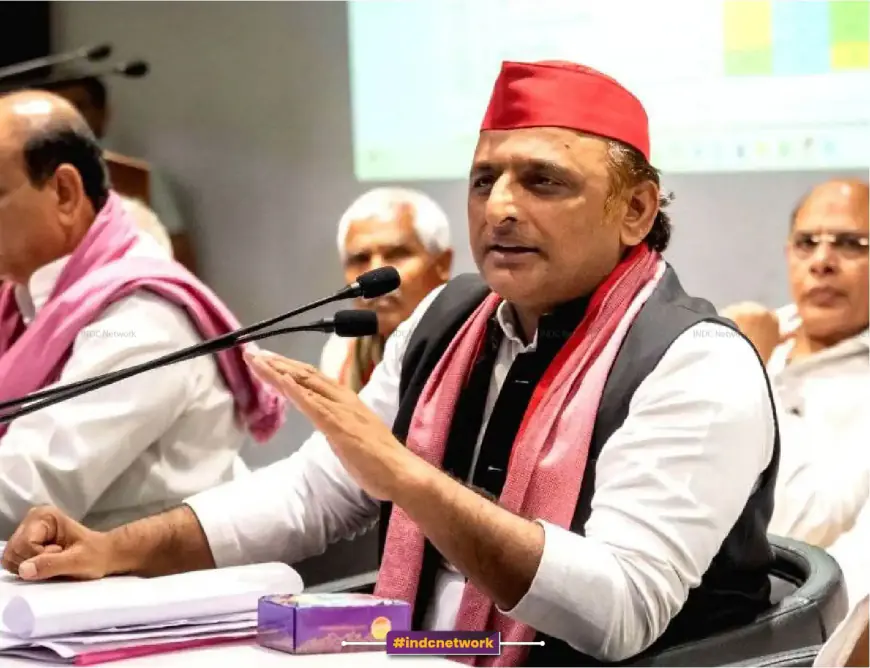SP’s Aggressive PDA Strategy in UP By-Elections: Muslim, OBC, and Dalit Candidates to Shape the Contest
The Samajwadi Party (SP) has unveiled its candidate list for the UP by-elections, focusing on its PDA (Backward-Dalit-Minority) strategy. Out of 9 seats, 4 have been allotted to Muslim candidates, 3 to OBCs, and 2 to Dalit candidates. This move highlights SP’s effort to strengthen its voter base in these key constituencies. As BJP and RLD prepare their own combinations, the by-elections are shaping up to be a major political showdown between PDA and BJP’s OBC-centric campaign.

INDC Network : Uttar Pradesh : In the run-up to the Uttar Pradesh by-elections, the Samajwadi Party (SP) has made a bold move by unveiling its PDA (Backward-Dalit-Minority) strategy. Out of the 9 seats for which candidates have been announced, SP has fielded 4 Muslim candidates, 3 OBC candidates, and 2 Dalit candidates, demonstrating its focus on consolidating support from minority and backward communities.
This strategic move is designed to strengthen SP’s voter base, especially among communities that traditionally support the party. It is being viewed as part of Akhilesh Yadav’s plan to build a robust electoral alliance in the face of a strong challenge from the Bharatiya Janata Party (BJP) and its allies.
Muslim Representation: SP’s Key Bet
Muslim candidates will contest from 4 key seats: Phulpur, Kundarki, Sisamau, and Meerapur. This is in line with SP’s effort to solidify its support among the Muslim community, which has long been a cornerstone of its vote bank. The party hopes that this focus on Muslim representation will help counterbalance the BJP’s growing influence in these areas.
Dalit and OBC Candidates: Strengthening the Alliance
SP has fielded Dalit candidates on two significant seats, one of which is the Ghaziabad Sadar seat. Singh Raj Jatav, a Dalit, will be the party's face here. This seat has historically been a tough challenge for SP, but by betting on the Dalit-Muslim equation, the party hopes to replicate its success in Ayodhya and other constituencies.
Similarly, SP has placed Charu Kane, a candidate from the Jatav community, on Aligarh’s Khair reserved seat. This selection is unique because Charu is married into a Jat family, and the party sees this as an opportunity to create an alliance between Jatavs and Jats. Charu’s shift from Bahujan Samaj Party (BSP) to SP has further added an interesting twist to the political equation here.
Advertisement- With the help of nexstartup.in you can make your business even better. Do give a chance to Nexstartup to serve you because they work on quality.
- Graphic Designing
- Video Editing
- Digital Marketing
- Web Development
- App Development
- UI & UX Design
and many more services......
BJP and RLD’s Counters
On the other hand, BJP and Rashtriya Lok Dal (RLD) are also gearing up for a competitive fight. The BJP-RLD alliance has focused heavily on OBC representation, fielding 5 OBC candidates and 1 Dalit candidate. Meanwhile, they have also placed candidates from the Brahmin and Thakur communities on 3 other seats.
The RLD has fielded Mithlesh Pal, from the Pal community, as its candidate for the Meerapur seat, signaling its own focus on balancing caste equations. As the contest heats up, the PDA strategy is at the core of SP's campaign, while the BJP has kept OBC candidates front and center in its election narrative.
PDA vs BJP: A Strategic Showdown
This election is being viewed as a head-to-head contest between SP’s PDA strategy and BJP’s OBC-centric approach. Both parties are working hard to solidify their respective vote banks, knowing that these by-elections are crucial for setting the tone for the upcoming general elections.
With SP’s aggressive push for minority and backward representation, and BJP's focus on OBCs, the stage is set for a fierce political battle in Uttar Pradesh. The outcome of these by-elections could significantly impact the larger political landscape of the state.










